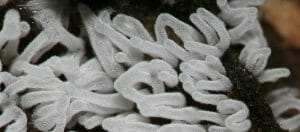Unicellular fungi like yeast reproduce by budding off daughter cells. Multicellular fungi reproduce by making spores. Mold is a multicellular fungus. It consists of filaments called hyphae that can bunch together into structures called mycelia. Several mycelia grouped together are a mycelium and these structures form the thallus or body of the mold. An example of a multicellular fungus is Rhizopus stolonifera. It is a bread mold that also causes blight in rice seedlings.
The spores of multicellular fungi have both male and female reproductive organs, so these plants reproduce asexually. Spores have been fertilized by the time they are ejected from a plant and carried to new locations by the wind, water, insects and birds. After they reach their final location, spores can survive in very harsh environments and can go dormant until environmental conditions are best for them to grow.

The image above shows the slime mold Ceratiomyxa fruticulosa. The tiny white spots are the spores of the plant.
References
- Fungi. (n.d.). In Lumen Learning. Retrieved January 9, 2018 from https://courses.lumenlearning.com/microbiology/chapter/fungi/
